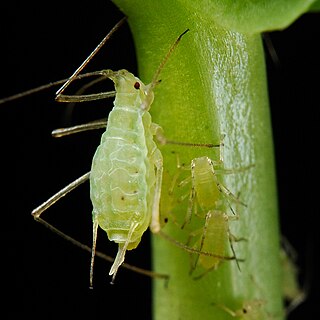 W
WAcyrthosiphon pisum, commonly known as the pea aphid, is a sap-sucking insect in the family Aphididae. It feeds on several species of legumes worldwide, including forage crops, such as pea, clover, alfalfa, and broad bean, and ranks among the aphid species of major agronomical importance. The pea aphid is a model organism for biological study whose genome has been sequenced and annotated.
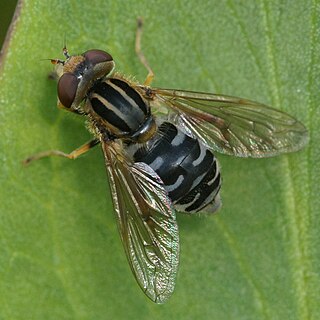 W
WAnasimyia interpuncta is a European species of hoverfly.
 W
WAncistrocerus trifasciatus is a Palearctic species of potter wasp.
 W
WAndrena marginata, sometimes called the small scabious mining bee is a species of the sand bee (Andrena) genus. It feeds on different nectar-bearing plants of the family Dipsacaceae, like field scabious and Devil's-bit scabious, though has also been observed foraging on knapweed and creeping thistle. The female builds a nest in the ground and fills the cells with a mixture of nectar and pollen. One egg is placed in each cell and the larva hatches, grow and pupates within the nest. The adults emerge in spring after hibernation.
 W
WApethymus serotinus is a Palearctic species of sawfly.
 W
WThe banded darter is a European species of dragonfly of the family Libellulidae.
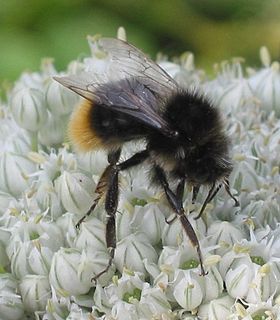 W
WBombus ruderarius, commonly known as the red-shanked carder bee or red-shanked bumblebee, is a species of bumblebee found in Eurasia.
 W
WCentroptilum luteolum is a species of small minnow mayfly in the family Baetidae. It is found in Europe.
 W
WChrysotoxum cautum is a species of hoverfly. It is found in southern Britain and Europe East into the Palearctic but is normally encountered in small numbers. The larvae are thought to feed on root aphids. Adults are usually found on the edges of woodland or scrub or along hedgerows where they visit a wide range of flowers.
 W
WConops quadrifasciatus, the yellow-banded conops, is a species of fly from the genus Conops in the family Conopidae.
 W
WCratichneumon culex is a species of the parasitic wasp of the family Ichneumonidae. The species was first described by Müller in 1776.
 W
WCuliseta annulata is a species of mosquito in the family Culicidae. It is found in the Palearctic.
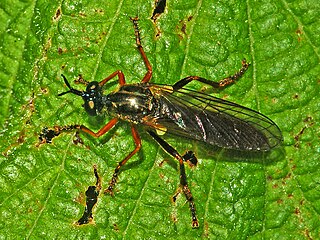 W
WDioctria rufipes, the common red-legged robberfly, is a species of robber fly in the subfamily Dasypogoninae of the family Asilidae.
 W
WEpisyrphus balteatus, sometimes called the marmalade hoverfly, is a relatively small hoverfly (9–12 mm) of the Syrphidae family, widespread throughout the Palaearctic region, which covers Europe, North Asia, and North Africa. The upper side of the abdomen is patterned with orange and black bands. Two further identification characters are the presence of secondary black bands on the third and fourth dorsal plates and faint greyish longitudinal stripes on the thorax. Its color patterns may appear wasp-like to other animals, such as birds, protecting it from predation.
 W
WEriothrix rufomaculata is a fly in the family Tachinidae.
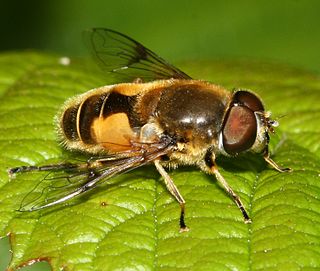 W
WEristalis horticola is a Palearctic species of hoverfly.
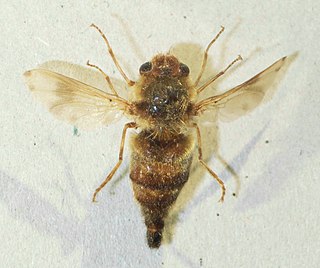 W
WGasterophilus intestinalis, also known as horse bot fly, is a species of insect of the family Oestridae, and is found worldwide. The adults, which have a bumblebee-like appearance, are prominently active in the summer. G. intestinalis is primarily a parasite of horses, mules and donkeys.
 W
WGonia capitata is a Palaearctic species of fly in the family Tachinidae.
 W
WHilara maura is a species of dance fly, in the fly family Empididae.
 W
WThe horehound bug is a stink bug which sucks the sap of the horehound plant, causing wilting of new shoots. They have five nymphal stages in their development. Although they usually attack horehound, they may also swarm on a variety of other trees and shrubs.
 W
WHybos femoratus is a species of fly in the family Hybotidae. It is found in the Palearctic.
 W
WThe Large red damselfly, Pyrrhosoma nymphula, is a species of damselflies belonging to the family Coenagrionidae.
 W
WLeptogaster cylindrica is a Palearctic species of robber fly in the family Asilidae.
 W
WLeucozona laternaria is a European species of hoverfly.
 W
WLispe tentaculata is a fly from the family Muscidae. It is found in the Palearctic.
 W
WMusca autumnalis, the face fly or autumn housefly, is a pest of cattle and horses.
 W
WMyzus persicae, known as the green peach aphid, greenfly, or the peach-potato aphid, is a small green aphid. It is the most significant aphid pest of peach trees, causing decreased growth, shrivelling of the leaves and the death of various tissues. It is also acts as a vector for the transport of plant viruses such as cucumber mosaic virus (CMV), potato virus Y (PVY) and tobacco etch virus (TEV). Potato virus Y and potato leafroll virus can be passed to members of the nightshade/potato family (Solanaceae), and various mosaic viruses to many other food crops.
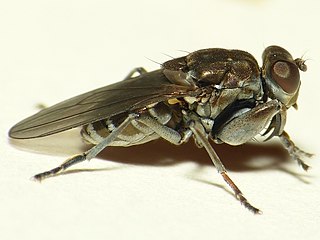 W
WOchthera mantis, the mantis fly, is a shore fly. The species was first described by Charles De Geer in 1776.
 W
WPhysocephala nigra is a species of fly from the genus Physocephala in the family Conopidae. Their larvae are endoparasites of bumble bees of the genus Bombus.
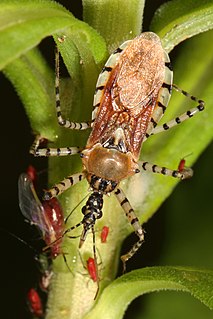 W
WPselliopus cinctus is a species of assassin bug in the family Reduviidae. It is found in North America.
 W
WPsococerastis gibbosa is a species of Psocoptera from the Psocidae family that can be found in Great Britain and Ireland. They are also common in Austria, Benelux, Bulgaria, Croatia, Finland, France, Germany, Hungary, Italy, Latvia, Poland, Romania, Spain, Switzerland, and Scandinavia. The species are yellowish-black coloured, and are striped.
 W
WRhagio annulatus is a Palearctic species of snipe fly in the family Rhagionidae.
 W
WRhyothemis phyllis, known as the yellow-striped flutterer or yellow-barred flutterer, is a species of dragonfly of the family Libellulidae, widespread in South-east Asia, including Cambodia, China, India, Indonesia, Lao People's Democratic Republic, Malaysia, Myanmar, Singapore, Taiwan, Thailand, Vietnam, and northern Australia.
 W
WScenopinus niger , a 'window fly', is a member of the Scenopinidae family of flies. It is found in the Palearctic.
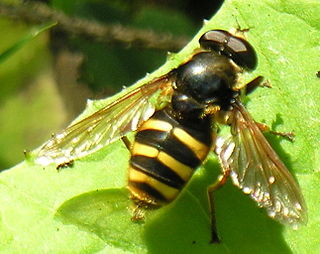 W
WSericomyia silentis, is a species of hoverfly. It is widespread throughout the Palearctic but normally encountered in small numbers in mountain regions and moorland and bog locations.
 W
WSericomyia (Arctophila) superbiens is a Palearctic species of hoverfly. It is a bumblebee mimic.
 W
WSinea diadema is a species of assassin bug family (Reduviidae), in the subfamily Harpactorinae. It is native to North America and found in the Midwest in fields, often associated with goldenrod Solidago missouriensis Nuttall.
 W
WSiphona geniculata is a Palearctic species of fly in the family Tachinidae.
 W
WStagonomus venustissimus, common name woundwort shieldbug, is a species of shieldbug belonging to the family Pentatomidae, subfamily Pentatominae.
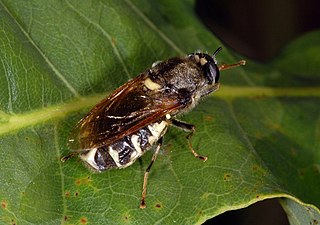 W
WStratiomys singularior, the flecked general, is a Palearcticspecies of soldier fly.
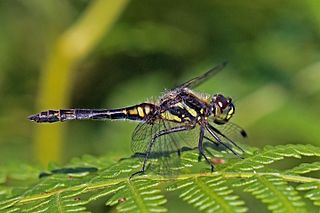 W
WSympetrum danae, the black darter or black meadowhawk is a dragonfly found in northern Europe, Asia, and North America. At about 30 mm (1.2 in) long, it is Britain's smallest resident dragonfly. It is a very active late summer insect typical of heathland and moorland bog pools.
 W
WTenthredo ferruginea is a Palearctic species of sawfly.
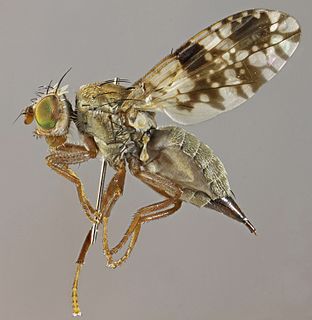 W
WTephritis leontodontis is a species of fly in the family Tephritidae, the gall flies. It is found in the Palearctic. The larvae feed on Scorzoneroides autumnalis.
 W
WTipula fulvipennis is a species of true craneflies.
 W
WTrixa conspersa is a species of fly in the family Tachinidae. It is generally found in the meadows, hedgerows and woodland edge in Britain, around the month of May to the end of July.
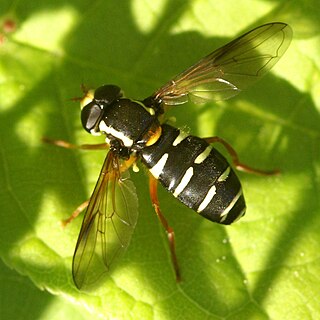 W
WXanthogramma citrofasciatum is a species of hoverfly found in grasslands from Ireland to western Siberia. The larvae live in ant Lasius colonies where they feed on the aphids tended by the ants.
 W
WXanthogramma pedissequum is a species of hoverfly.
 W
WZatypota percontatoria is a species of parasitoid wasps that is part of the order Hymenoptera and the family Ichneumonidae responsible for parasitizing arachnids, specifically those of the family Theridiidae.